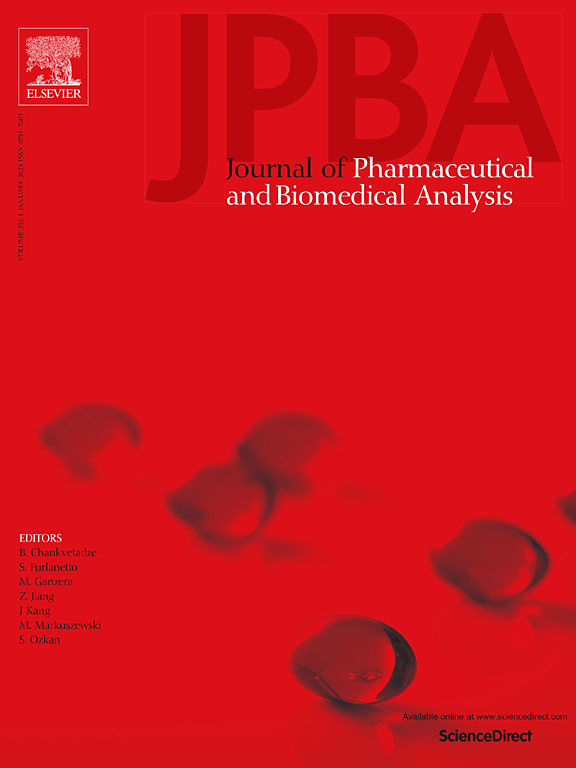Structure elucidation and confirmation of unknown impurities in an animal health product by the strategy of utilizing a variety of advanced analytical techniques
IF 3.1
3区 医学
Q2 CHEMISTRY, ANALYTICAL
Journal of pharmaceutical and biomedical analysis
Pub Date : 2025-01-28
DOI:10.1016/j.jpba.2025.116713
引用次数: 0
Abstract
During stability test of an animal health finished drug product (liquid transdermal formulation packed in plastic syringe), several unexpected peaks were observed in the HPLC chromatograms. The structure and possible origin of these unknown peaks needed to be determined to ensure the safety and efficacy of the finished drug product. Each unknown peak poses different analytical challenges for full structure elucidation. In this paper, we presented the strategies and experimental results for the identification of these unexpected peaks using a combination of different advanced analytical techniques, namely HPLC/PDA, High Resolution MS and MS2, and headspace GC/MS. The orthogonal information provided by UV spectra, HRMS data, elemental composition, and MS2 fragmentation of these unknown peaks were used to propose the most probable structures for these unknown peaks. The proposed structures of these unknown peaks were fully confirmed by reference materials. The origins of these compounds were identified through an extraction study of the primary packaging materials. Hence, the unknown peaks were confirmed as leachable compounds from the primary packaging materials. Successful identification of these compounds enables quantification and toxicological evaluation. Additionally, the identification of these leachable compounds can be used to improve the primary package production process. By minimizing or eliminating the use of these compounds in the package production process, the risk of these compounds migrating into final finished drug product will be minimized in the future.
求助全文
约1分钟内获得全文
求助全文
来源期刊
CiteScore
6.70
自引率
5.90%
发文量
588
审稿时长
37 days
期刊介绍:
This journal is an international medium directed towards the needs of academic, clinical, government and industrial analysis by publishing original research reports and critical reviews on pharmaceutical and biomedical analysis. It covers the interdisciplinary aspects of analysis in the pharmaceutical, biomedical and clinical sciences, including developments in analytical methodology, instrumentation, computation and interpretation. Submissions on novel applications focusing on drug purity and stability studies, pharmacokinetics, therapeutic monitoring, metabolic profiling; drug-related aspects of analytical biochemistry and forensic toxicology; quality assurance in the pharmaceutical industry are also welcome.
Studies from areas of well established and poorly selective methods, such as UV-VIS spectrophotometry (including derivative and multi-wavelength measurements), basic electroanalytical (potentiometric, polarographic and voltammetric) methods, fluorimetry, flow-injection analysis, etc. are accepted for publication in exceptional cases only, if a unique and substantial advantage over presently known systems is demonstrated. The same applies to the assay of simple drug formulations by any kind of methods and the determination of drugs in biological samples based merely on spiked samples. Drug purity/stability studies should contain information on the structure elucidation of the impurities/degradants.

 求助内容:
求助内容: 应助结果提醒方式:
应助结果提醒方式:


